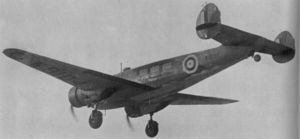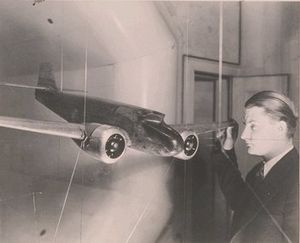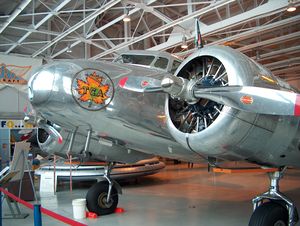PlaneSpottingWorld welcomes all new members! Please gives your ideas at the Terminal.
Lockheed L-10 Electra
| L-10 Electra/C-36 | |
|---|---|
| Amelia Earhart's Electra 10E | |
| Type | Utility aircraft |
| Manufacturer | Lockheed |
| Maiden flight | 23 February 1934 |
| Number built | 149 |
| Variants | Lockheed L-12 Electra Junior Lockheed L-14 Super Electra |
The Lockheed L-10 Electra was a twin-engine, all-metal monoplane airliner developed by the Lockheed Aircraft Corporation in the 1930s to compete with the Boeing 247 and Douglas DC-2.
Contents
Design and development
The Electra was Lockheed's first all-metal and twin-engine design. (However, some of Lockheed's wooden designs, such as the Orion had been built by Detroit Aircraft Corporation with metal fuselages.) The name Electra came from a star in the Pleiades. The prototype made its first flight on 23 February 1934 with Marshall Headle at the controls.
Wind tunnel work on the Electra was undertaken at the University of Michigan. Much of the work was performed by a student assistant, Clarence Johnson. He suggested two changes be made to the design: changing the single tail to double tails (later a Lockheed trademark), and deleting oversized wing fillets. Both of these suggestions were incorporated into production aircraft. Upon receiving his master's degree, Johnson joined Lockheed as a regular employee, ultimately leading the Skunk Works in developing advanced aircraft such as the SR-71 Blackbird.
Operational history
Aviatrix Amelia Earhart disappeared in a highly-modified Electra on an attempted around-the-world flight in 1937.
Later in 1937, H.T. "Dick" Merrill and J.S. Lambie accomplished a round-trip crossing of the Atlantic Ocean; this feat was declared the first round-trip commercial crossing of that ocean, and it won them the Harmon Trophy. On the eastbound trip, they carried newsreels of the crash of the Hindenburg, and on the return trip, they brought photographs of the coronation of King George VI.
Many Electras, and descendants of the design (the L-12 Electra Junior and L-14 Super Electra), were pressed into military service during World War II (as the C-36 with the USAAF). By the end of the war, the Electra design was obsolete.
Variants
The Electra was produced in several variants, for both civilian and military customers. Lockheed built a total of 149 Electras.
- Electra 10A
- Powered by two Pratt & Whitney R-985-13, 450 hp. each; 101 produced.
- Three built as Y1C-36 / C-36 / UC-36.
- Fifteen impressed as C-36A, but later re-designated UC-36A.
- Three built as XR20-1 / R20-1 for Secretary of the Navy.
- One built as Y1C-37 / C-37 / UC-37 for Chief of National Guard Bureau
- Electra 10B
- Powered by Wright R-975-13, 440 hp (340 kW) each; 18 produced
- Seven impressed as C-36C, but later re-designated UC-36C.
- One built as XR30-1 for use by the Secretary of Treasury, operated by the US Coast Guard.
- Electra 10C
- Powered by Pratt & Whitney Wasp SC1, 450 hp (336-kW) each; eight produced for Pan American Airways.
- Electra 10-D
- Proposed military transport version; none built.
- Electra 10-E
- Powered by Pratt & Whitney R-1340-49 radials of 600 hp (450 kW) each; 15 produced. The version used by Amelia Earhart.
- Five impressed as C-36B, but later re-designated UC-36B
- XC-35
- Experimental pressurized research model powered by supercharged Pratt & Whitney XR-1340-43, 550 hp (410 kW) each. The one production model was tested for the War Department by Lieutenant Ben Kelsey. For this work, the Army Air Corps was awarded the 1937 Collier Trophy. The XC-35 is currently in storage in the collection of the National Air and Space Museum.
Survivors
Canada is the home of two Model 10As. The first aircraft in the Air Canada (then called Trans-Canada Air Lines) fleet was an Electra L10A, "TCA." Two Electras were delivered to Trans-Canada Air Lines (TCA) in 1937. They were based in Winnipeg and used for pilot training. Trans-Canada Air Lines ordered three more for transcontinental service; "CF-TCC" was one of those three. These former TCA machines and other 10As were acquired by the RCAF during Second World War, and later sold to private operators.
TCA survived into the 1960s when Ann Pellegreno between June 7 and July 10, 1967 flew TCA on a round-the-world flight to commemorate Amelia Earhart’s last flight in 1937. The Canada Aviation Museum acquired this aircraft after the commemorative flight. Manufactured in 1937, the Museum example was the first new aircraft purchased by Trans-Canada Air Lines and served with the company until transferred to the RCAF in 1939. Sold in 1941 to a private operator, it was flown until 1967 by various owners. Air Canada restored the aircraft in 1968 and donated it to the Museum.
TCC was another former Trans-Canada Air Lines original. CF-TCC was found in Florida by a vacationing Air Canada employee in the early 1980s. Arrangements were made for it to be brought back to Winnipeg where it was restored. It was flown across Canada in 1987 to commemorate Air Canada's 50th Anniversary.
Air Canada maintains the aircraft and uses it to promote the airline. The aircraft was placed on display at Expo 86 after recreating the original TCA cross-country flight in 1937 and continues to be displayed at air shows and conferences. In 2006, it was flown from Toronto to Washington DC for the Airlines International Show [1]. For most of the year, TCC resides at the Western Canada Aviation Museum where it is one of the feature aircraft displayed.
Two L-10 Electras are also preserved in New Zealand's Museum of Transport and Technology at Auckland. Another Auckland-based Electra, owned by Rob Mackley, is under restoration to flying condition.
Operators

Military operators
Civil operators
- Aeroput (Yugoslavia) (now known as Jat Airways)
- British Airways
- Canadian Airways
- Chicago & Southern
- Continental Airlines
- Delta Air Lines
- Eastern Airlines
- Guinea Airways
- Hanford
- LARES (Romania)
- LAN Chile
- LOT Polish Airlines (ten in 1936-1939)
- National Airlines
- National Airways
- Northwest Airlines
- Pan American (Alaska Division)
- Trans-Canada Air Lines
- Union Airways of N.Z. Ltd
Specifications (Electra 10A)
Template:Aircraft specification
References
- Francillon, René J. Lockheed Aircraft since 1913. Annapolis: Naval Institute Press, 1987. ISBN 0-85177-835-6.
External links
- XC-35 in the collection of the National Air and Space Museum
- XC-35 from National Museum of the United States Air Force
Related content
Related development
Comparable aircraft
Designation sequence
- Army: C-32 - C-33 - C-34 - XC-35 - C-36 - C-37 - C-38 - C-39 - C-40
- Lockheed: L-8 - L-8A - L-9 - L-10 - L-12 - L-14 - L-15
Related lists
See also
Template:USAF transports Template:USN transports
Airliners and Civil Transports: Vega · Electra · Electra Junior · Super Electra · Lodestar · Constellation · Saturn · L-188 Electra · L-402 · JetStar · L-1011 TriStar
Military Transports : C-64 · C-121 · R6V · C-130 Hercules · C-141 Starlifter · C-5 Galaxy
Fighters: F-22 Raptor · F-35 Lightning II · F-94 Starfire · F-104 Starfighter · F-117 Nighthawk · P-38 Lightning · P-80 Shooting Star · T-33 Shooting Star
Patrol and reconnaissance : Hudson · PV-1 Ventura · PV-2 Harpoon · P-2 Neptune · P-3 Orion · CP-140 Aurora/CP-140A Arcturus · U-2 · SR-71 Blackbird · S-3 Viking
Lists relating to aviation | |
|---|---|
| General | Timeline of aviation · Aircraft · Aircraft manufacturers · Aircraft engines · Aircraft engine manufacturers · Airports · Airlines |
| Military | Air forces · Aircraft weapons · Missiles · Unmanned aerial vehicles (UAVs) · Experimental aircraft |
| Notable incidents and accidents | Military aviation · Airliners · General aviation · Famous aviation-related deaths |
| Records | Flight airspeed record · Flight distance record · Flight altitude record · Flight endurance record · Most produced aircraft |


